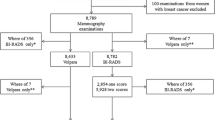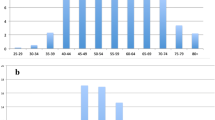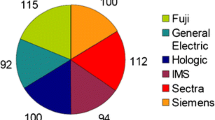Abstract
Objective
This study was done to assess breast density on digital mammography and digital breast tomosynthesis according to the visual Breast Imaging Reporting and Data System (BI–RADS) classification, to compare visual assessment with Quantra software for automated density measurement, and to establish the role of the software in clinical practice.
Materials and methods
We analysed 200 digital mammograms performed in 2D and 3D modality, 100 of which positive for breast cancer and 100 negative. Radiological density was assessed with the BI–RADS classification; a Quantra density cut-off value was sought on the 2D images only to discriminate between BI–RADS categories 1–2 and BI–RADS 3–4. Breast density was correlated with age, use of hormone therapy, and increased risk of disease.
Results
The agreement between the 2D and 3D assessments of BI–RADS density was high (K 0.96). A cut-off value of 21 % is that which allows us to best discriminate between BI–RADS categories 1–2 and 3–4. Breast density was negatively correlated to age (r = −0.44) and positively to use of hormone therapy (p = 0.0004). Quantra density was higher in breasts with cancer than in healthy breasts.
Conclusions
There is no clear difference between the visual assessments of density on 2D and 3D images. Use of the automated system requires the adoption of a cut-off value (set at 21 %) to effectively discriminate BI–RADS 1–2 and 3–4, and could be useful in clinical practice.




Similar content being viewed by others
References
Ciatto S, Bernardi D, Calabrese M et al (2012) A first evaluation of breast radiological density assessment by QUANTRA software as compared to visual classification. Breast 21:503–506
Wolfe JN (1976) Risk for breast cancer development determined by mammographic parenchymal pattern. Cancer 37:2486–2492
Ciatto S, Zappa M (1993) A prospective study of the value of mammographic patterns as indicators of breast cancer risk in a screening experience. Eur J Radiol 17:122–125
Ciatto S, Visioli C, Paci E et al (2004) Breast density as a determinant of interval cancer at mammographic screening. Br J Cancer 90:393–396
American College of Radiology (2003) Breast Imaging Reporting and Data System Atlas (BI–RADS® Atlas). Reston, VA. http://www.acr.org. Last accessed June 2012
Ciatto S, Houssami N, Apruzzese A et al (2005) Categorizing breast mammographic density: intra-and interobserver reproducibility of BI–RADS density categories. Breast 14:269–275
Bernardi D, Pellegrini M, Di Michele S et al (2012) Interobserver agreement in breast radiological density attribution according to BI–RADS quantitative classification. Radiol Med 117:519–528
Tuncbilek N, Sezer A, Uğur U et al (2009) Qualitative and quantitative analysis of fibroglandular tissue in the digital environment. In: Proffered paper at 10th National Congress of Breast Diseases, Izmir, Turkey
Johns PC, Yaffe MJ (1987) X-ray characterization of normal and neoplastic breast tissue. Phys Med Biol 32:675–695
Boone JM, Fewell TR, Jennings RJ (1997) Molybdenum, rhodium, and tungsten anode spectral models using interpolating polynomials with application to mammography. Med Phys 24:1863–1874
Skippage P, Wilkinson L, Allen S et al (2013) Correlation of age and HRT use with breast density as assessed by Quantra™. Breast J 19:79–86
Pinker K, Perry N, Milner S et al (2010) Validation of a new automated volumetric breast density measurement system as a marker of breast cancer risk. Breast Cancer Res 12(Suppl 3):O1. doi:10.1186/bcr2648 (Published online 2010 October 25)
Hartman K, Hoghnam R, Warren R et al (2008) Volumetric assessment of breast tissue composition from FFDM images. In: Krupinksi EA (ed) Proceedings of the international workshop on digital mammography, Tucson, AZ, USA, IWDM 2008, LNCS 5116, pp 33–39
Boyd NF, Byng JW, Jong RA et al (1995) Quantitative classification of mammographic densities and breast cancer risk: results from the Canadian National Breast Screening Study. J Natl Cancer Ins 87:670–675
Byng JW, Boyd NF, Fishell E et al (1994) The quantitative analysis of mammographic densities. Phys Med Biol 39:1629–1638
Byng JW, Yaffe MJ, Jong RA et al (1998) Analysis of mammographic density and breast cancer risk from digitised mammograms. Radiographics 18:1587–1598
Shepherd JA, Kerlikowske KM, Smith-Bindman R et al (2002) Measurement of breast density with dual X-ray absorptiometry: feasibility. Radiology 223:554–557
Highnam R, Brady M, Shepstone B (1996) A representation for mammographic image processing. Med Image Anal 1:1–18
Tagliafico A, Tagliafico G, Astengo D et al (2012) Mammographic density estimation: one-to-one comparison of digital mammography and digital breast tomosynthesis using fully automated software. Eur Radiol 22:1265–1270
Rafferty E, Smith A, Niklason L (2009) Comparison of three methods of estimating breast density: BI–RADS density scores using full field digital mammography, BI–RADS density scores using breast tomosynthesis, and volumetric breast density. In: Presented RSNA, SSM01-04, Wednesday, December 2 2009, 15:30–15:40, Chicago, IL, USA
Bakic PR, Carton AK, Kontos D et al (2009) Breast percent density: estimation on digital mammograms and central tomosynthesis projections. Radiology 252:40–49
Wolfe JN (1976) Breast patterns as an index of risk for developing breast cancer. Am J Roentgenol 126:1130–1137
McCormack VA, dos Santos SI (2006) Breast density and parenchymal patterns as markers of breast cancer risk: a meta-analysis. Cancer Epidemiol Biomarkers Prev 15:1159–1169
Mandelson MT, Oestreicher N, Porter PL et al (2000) Breast density as a predictor of mammographic detection: comparison of interval- and screen-detected cancers. J Natl Cancer Inst 92:1081–1087
Boyd NF, Martin LJ, Bronskill M (2010) Breast tissue composition and susceptibility to breast cancer. J Natl Cancer Inst 102:1224–1237
Boyd NF, Lockwood GA, Byng JW et al (1998) Mammographic densities and breast cancer risk. Cancer Epidemiol Biomarkers Prev 7:1133–1144
Lip G, Zakharova N, Duffy SW et al (2010) Breast density as a predictor of breast cancer risk. Breast Cancer Res 12(Suppl 3):P1. doi:10.1186/bcr2654 (Published online 2010 October 25)
Eriksson L, Czene K, Rosenberg L et al (2012) The influence of mammographic density on breast tumor characteristics. Breast Cancer Res Treat 134:859–866. doi:10.1007/s10549-012-2127-0
Pollán M, Ascunce N, Ederra M et al (2013) Mammographic density and risk of breast cancer according to tumor characteristics and mode of detection: a Spanish population-based case-control study. Breast Cancer Res 15:R9
Conflict of interest
E Regini, G. Mariscotti, M. Durando, G. Ghione, A. Luparia, P.P. Campanino, C.C. Bianchi, L. Bergamasco, P. Fonio, G. Gandini declare that they have no conflict of interest related with the publication of this manuscript.
Author information
Authors and Affiliations
Corresponding author
Rights and permissions
About this article
Cite this article
Regini, E., Mariscotti, G., Durando, M. et al. Radiological assessment of breast density by visual classification (BI–RADS) compared to automated volumetric digital software (Quantra): implications for clinical practice. Radiol med 119, 741–749 (2014). https://doi.org/10.1007/s11547-014-0390-3
Received:
Accepted:
Published:
Issue Date:
DOI: https://doi.org/10.1007/s11547-014-0390-3




